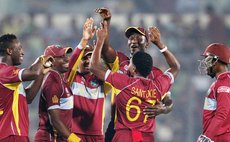Crowd pressure
Generally, the biggest crowds are these days expected in India for international cricket matches. It is not unusual to have as many as forty or fifty thousand turning up for a day's play even for Test matches! The understanding exists that the larger a crowd, the greater the chances of a flaring up of emotions. And that's what may have occurred on Monday when India were faced with attempting to come to grips with the visiting South Africans in the second of three T20 engagements. It was pivotal that the home side should come up strong, having lost the first a few days earlier. Unhappily for India, South Africa won the toss and decided to bowl first and limited India to a paltry score of 92 all out in 17 overs and two balls on a surface exhibiting variable pace and bounce. Soon enough it became clear South Africa would sail to victory without undue fuss. This did not amuse the home crowd at Cuttach.
When South Africa advanced to 68 for 3 wickets, they needed a further 25 runs to win from around 36 balls, not a particularly daunting task. An expression of frustration manifested itself in a number of bottles thrown onto the field from a section of the crowd positioned high up in one of the stands. The match was halted for twenty minutes for the missiles to be cleared and for police security to be reinforced. That did not help much to smooth the situation and more objects were hurled onto the playing area. During this time an Indian commentator was heard to say the police were engaged in viewing the match rather than scrutinizing the trouble points in the crowd. After a further break of twenty-five minutes the match continued with South Africa 96 for 4 winning by six wickets. Closure was facilitated by certain crowd elements being expelled from the ground.
What intrigued me was recourse, while an outcome had still to be reached, to an examination of the match position relevant to the Duckworth-Lewis system. It was in my view appalling to even contemplate the use of a system explicitly devised to deal with situations relating to arriving at a result in respect to time lost through intervention by the weather or other natural causes. South Africa were well ahead of the par score indicated by Duckworth-Lewis, but suppose India had been ahead when the crowd trouble arose, would it be fair to penalize the batting side in face of trouble coming from the partisan spectators?
From our knowledge of how a sane outlook is utilized in dealing with crowd trouble, say, in football, the home team bears penalty for disturbances by its supporters. It goes to the point where the home team is debited with a defeat, sometimes leading to its future home matches mandated to be played behind closed doors – without any crowd, if it comes to that! All at the financial expense of the team whose supporters allegedly caused the relevant trouble.
Bottle throwing has raised its ugly head more than once in the Caribbean in Test match situations. The BBC once reported from London that a match between the West Indies and England was "stopped by rain – what rain, a rain of bottles!" The match was at Bourda, Guyana, the bottles precipitated after an obscure West Indies batsman was adjudged run out – by a West Indian umpire, mark you! Clearly, the whole incident transpired from the glaring frustrations of the home crowd with the clear ineptness of the West Indian batsmen in coping with the England bowling.
There is some merit in the argument against allowing glass bottles to form part of the drinks service in such crowds. A glass bottle, from the weight factor, easily suggests itself as an effective missile, quite different from the proposition implied in hurling a plastic or paper bottle. Then, too, even if the missiles do not strike any of the players directly, there is the matter of broken fragments posing physical danger to the match participants.
Don't, in the interest of mitigating a missile intrusive situation, presume that players can help by throwing the objects off the field of play. In 1979, Sylvester Clarke of the West Indies thought he was being helpful by returning a brick to the Indian crowd, only to come under serious threat retaliatory to the brick purportedly hitting a young boy. All this happened in a cricket crazy country which thirty-six years ago contended with crowd elements using mirrors to dazzle visiting batsmen! Very bad, but not half as bad as mobs attacking the visitors bus, and damaging its glass windows, causing its occupants to go to ground for cover.
All this provides backdrop to India staging the T20 World Cup Tournament in March of next year. And how much all this poses as far as security implications go in the business of future staging of the immensely popular, Indian Premier League is left to conjecture. Time has come for the intensity of ground security at major international cricket matches to be heightened to exhaustive applications. Heaven forbid, let us never approach the time when the security surrounding a Test or other such match could be breached by drone invasion of a seriously malignant kind! It was bad enough sometime in the eighties when a championship boxing match suffered intrusion by an individual parachuting an unscheduled landing in close vicinity to the ring! If such intrusions become frequent, the words of a famous boxing promoter of the twenties could become true. His prophecy pointed to there being no need for spectators – only an enclosed ring and the pay per view television cameras! Let civility forestall any such futuristic aberrations. Let there be sport. Your team cannot always win: The first hand crowds we need. However, crowd pressure must not go uncontrolled.




